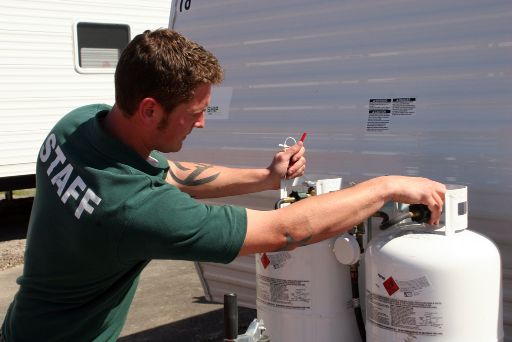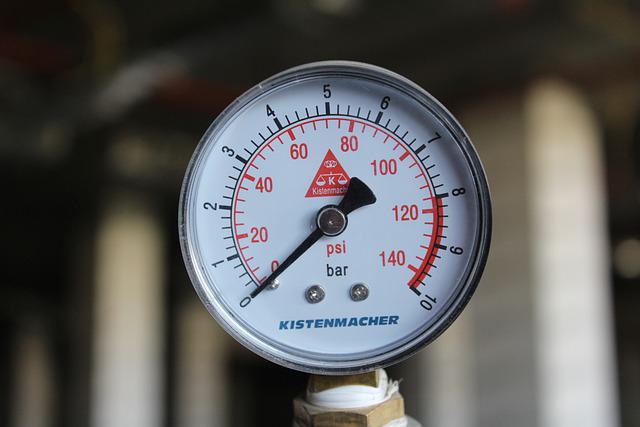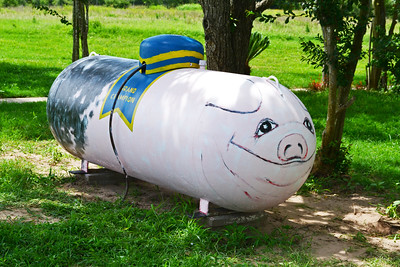
Do you question can propane tank can sit in the rain? Well, technically, it is possible without adverse effect. Suppliers and retailers do this. But there are safety precautions that need to be taken into considerations.
It is important not to store propane tanks on wet ground or any other surface that gets wet. This is because water can corrode the metal surface of the propane tank, leading to rust and other damage. In addition, water can create a conductive path that could lead to electrical shocks or other hazards if the propane tank comes into contact with electrical equipment or wires.
If the ground is wet, it is best to store propane tanks on a raised surface, such as a platform or shelf, to keep them out of contact with water. It is also important to keep propane tanks away from sources of heat and flame, as well as from areas where they could be knocked over or damaged.
Overall, it is important to store propane tanks safely and securely to prevent accidents and injuries. This includes avoiding wet or damp surfaces and keeping the tanks away from heat sources and potential hazards.
Leaving the tanks outdoors in this condition uncovered, increases the probability of rusting and corrosion and can cause the valve hard to turn and loosen and might shorten the lifespan of the tanks, especially when the tanks are steel because steel tanks are easily rusted. If a propane tank gets wet, it can corrode the tank. This can lead to leaks and potentially explosions. It is important to keep propane tanks dry and away from moisture.
There are a few things to keep in mind to ensure the safety and longevity of your tank. Make sure the tank is properly secured and not in danger of tipping over. Check the tank regularly for any leaks or damage. And finally, be sure to at least cover them with tarps to protect them from different weather conditions not just rain.
Rain-Specific Considerations for Propane Tanks
A. Potential for Rust and Corrosion
Rain exposure can significantly increase the potential for rust and corrosion on propane tanks, particularly if their protective coatings are compromised. Here’s what to consider:
- Vulnerability Points: Key areas such as welds, seams, and the base are more susceptible to moisture penetration and rust.
- Corrosion Rate: Factors that affect how quickly corrosion can set in, including the tank’s material, coating quality, and the presence of corrosive agents in the rain, like industrial pollutants or salt (in coastal areas).
- Long-term Impact: Understanding how consistent exposure to rain without proper maintenance can accelerate corrosion, potentially leading to leaks or structural failures over time.
B. Impact on Valves and Regulators from Rain Exposure
Valves and regulators are critical for the safe operation of a propane tank, and rain exposure can impact these components:
- Water Entry: Exploring how prolonged exposure to rain can allow water to seep into regulators and valves, potentially causing blockages or malfunctions.
- Rust Formation: The risks associated with rust forming on the moving parts or springs within valves and regulators, can impede their operation.
- Maintenance Challenges: Addressing the additional maintenance that may be required for these components in rainy climates, such as more frequent inspections and the use of water-displacing lubricants.
C. Safety Mechanisms in Place for Moisture-Related Incidents
Despite the challenges rain can pose, propane tanks are equipped with various safety mechanisms to deal with moisture-related incidents:
- Pressure Relief Valves: How these valves operate to prevent tank overpressure in the event of water ingress causing an increase in internal pressure.
- Protective Housings: A look at the design features that help shield sensitive components from rain, such as housings for valves and regulators.
- Double-walled Tanks: For some applications, double-walled tanks provide an extra layer of protection against corrosion.
- Alarms and Monitors: Innovative tank designs that include moisture sensors or alarms to alert owners of potential water intrusion.
- Emergency Protocols: Outlining the standard procedures for dealing with water contamination or corrosion issues, including emergency venting and tank repair or replacement protocols.
By comprehensively addressing these rain-specific considerations, propane tank owners and operators can better understand the risks and necessary precautions to ensure the longevity and safe operation of their tanks in rainy conditions.
How to Protect the Tanks from the Rain
Technically, you can just leave the propane tank outside in the rain without issue. However, if they stay there for a long period of time, inevitably, rush and corrosion on the body and valve will form. To protect the tanks from the rain here are simple solutions:
- Paint them with the appropriate type of paint. The paint should have some rust-inhibiting effect to withstand moisture while in the rain.
- Cover the tanks with a tarp. The tarp will protect them somehow from the elements not just rain.
- If you have just 1 or 2 tanks, you can simply place a sheet of plastic or wood on top to cover the valve. This is to prevent the valve from corroding due to the moisture of the rain. It will cause the valve to tighten.
- If the tanks are in the back of the house, and you don’t want to put them indoors for safety reasons, you can just simply place them in the area where they can be covered by the roof of the house to shield them from the rain.
Storing propane tanks outdoor
When storing propane tanks outdoors, it is important to choose a location that is well-ventilated and away from heat sources, flames, and sparks. Propane gas is heavier than air, so it will settle in low-lying areas. It is important to avoid storing propane tanks near drains, gutters, or other areas where water could collect.
Propane tanks should be stored in a vertical position, with the valve ending up. This will help to prevent the propane gas from escaping and will make it easier to connect the tank to the appliance or equipment. Propane tanks should also be properly secured to prevent them from falling or being knocked over.
It is important to keep propane tanks away from areas where they could be damaged or subjected to extreme temperatures. Avoid storing propane tanks near sources of heat, such as furnaces or water heaters, as well as in areas where they could be exposed to direct sunlight or freezing temperatures.
In addition to proper storage, it is important to regularly inspect propane tanks and cylinders for signs of damage or wear. Look for dents, rust, or other damage to the metal surface of the tank, as well as any leaks.
Rust can form on the surface because of moisture and water. Inspection is important to detect defects that could lead to leaks.
Are Propane Tanks Waterproof?
Propane tanks are not waterproof. Propane tanks are made of metal, which is not impervious to water. Water can corrode the metal surface of the propane tank, leading to rust and other damage. In addition, water can create a conductive path that could lead to electrical shocks or other hazards if the propane tank comes into contact with electrical equipment or wires.
While propane tanks are not waterproof, they are designed to be resistant to moisture. The metal surface of the propane tank is coated with a protective layer to prevent rust and other corrosion. In addition, the propane tank has a valve and other fittings that are designed to prevent leaks and protect against moisture.
However, propane tanks should still be stored in a well-ventilated area away from sources of moisture, such as wet ground or areas where water could collect. It is also important to keep propane tanks away from heat sources and flames, as well as from areas where they could be knocked over or damaged.
Overall, while propane tanks are not waterproof, they are designed to be resistant to moisture and protected against leaks and other hazards. It is important to store propane tanks safely and securely to prevent accidents and injuries.
Which Propane Tank Stands Wet COndition: Steel or Aluminum
Both steel and aluminum propane tanks have attributes that make them suitable for use in wet conditions, but each material reacts differently to moisture and has its own advantages and drawbacks.
| Steel Propane Tanks | |
|---|---|
| Corrosion Resistance | If the protective coatings on a steel tank are well-maintained, it will resist rust and corrosion effectively. However, if the coating is damaged or wears off, the exposed steel is susceptible to rust when in constant contact with moisture. |
| Maintenance | Steel tanks require regular inspection and maintenance to ensure that their protective coatings remain intact. Any rust spots need to be promptly addressed, usually by sanding the area down and applying a rust-inhibiting primer and paint. |
| Durability | They are very robust and, if properly maintained, can last for many years even in wet conditions. |
| Aluminum Propane Tanks | |
| Corrosion Resistance | Aluminum naturally forms an oxide layer that protects it from further corrosion. Even when this layer is scratched, it will reform and continue to protect the aluminum. This makes aluminum tanks highly resistant to corrosion caused by rainwater. |
| Maintenance | They generally require less maintenance than steel tanks in terms of corrosion control due to their inherent resistance to rust. |
| Durability | While aluminum is resistant to corrosion, it is also a softer metal than steel, which means it may be more prone to dents and punctures from physical impact. |
When considering which type of tank withstands wet conditions better, aluminum tanks have a clear advantage in terms of natural corrosion resistance. However, with proper maintenance and care, steel tanks can also endure wet environments effectively. The choice between the two often comes down to other factors, including cost, availability, required size, and the specific requirements of the installation location.
For applications near marine environments or where tanks are frequently exposed to wet conditions without the possibility of regular maintenance, aluminum might be the preferred choice due to its superior resistance to corrosion. For inland areas where diligent maintenance can be performed, steel tanks are often preferred due to their strength and cost-effectiveness.
Ways to store propane tanks to protect them from the elements
When storing propane tanks outdoors, it is important to choose a location that is well-ventilated and away from heat sources, flames, and sparks. Propane gas is heavier than air, so it will settle in low-lying areas. It is important to avoid storing propane tanks near drains, gutters, or other areas where water could collect.
Propane tanks should be stored in a vertical position, with the valve ending up. This will help to prevent the propane gas from escaping and will make it easier to connect the tank to the appliance or equipment. Propane tanks should also be properly secured to prevent them from falling or being knocked over.
It is important to keep propane tanks away from areas where they could be damaged or subjected to extreme temperatures. Avoid storing propane tanks near sources of heat, such as furnaces or water heaters, as well as in areas where they could be exposed to direct sunlight or freezing temperatures.
In addition to proper storage, it is important to regularly inspect propane tanks and cylinders for signs of damage or wear. Look for dents, rust, or other damage to the metal surface of the tank, as well as any leaks or other issues that could cause the propane gas to escape.
Overall, the best way to store propane tanks outdoors is to choose a well-ventilated, dry location that is away from heat sources, flames, and potential hazards. Propane tanks should be stored in a vertical position, secured to prevent them from falling, and regularly inspected for signs of damage or wear.
Maintenance and Care in Rainy Climates
A. Special Maintenance Tips for Propane Tanks in High-Rainfall Areas
- Routine Check-ups: Emphasize the importance of regular inspections to check for signs of rust and wear, especially after heavy rainfall.
- Protective Coatings: Recommend the application of weather-resistant paint or coatings that are specifically designed to prevent rust and detail the process for application.
- Drainage: Advice on ensuring proper drainage around the tank to prevent standing water, which can accelerate corrosion.
- Component Care: Provide tips on protecting valves, regulators, and other tank components from moisture—such as using protective covers and periodically applying silicone or other moisture-repellent sprays.
B. Storage Solutions and Protective Measures for Tanks During Rain
- Tank Positioning: Discuss the best practices for tank placement to avoid water pooling, including elevated platforms or stands where appropriate.
- Covers and Enclosures: Explore options for tank covers, canopies, or enclosures that can offer a barrier against direct rainfall while maintaining necessary ventilation.
- Flood Preparation: For areas prone to flooding, discuss anchoring methods or barriers to prevent tank buoyancy or movement.
- Vegetation Control: Explain how maintaining vegetation around the tank can prevent excess moisture and debris from affecting the tank’s exterior.
C. Inspection and Replacement Schedules Influenced by Weather Conditions
- Adjusted Timelines: Suggest how inspection frequencies may need to be increased in areas with high rainfall, along with a recommended schedule.
- Corrosion Monitoring: Offer guidance on monitoring for corrosion, including what signs to look for and how often to check.
- Part Replacement: Provide information on how weather conditions might necessitate more frequent replacement of certain tank components, such as regulators, hoses, and fittings.
- Record-Keeping: Highlight the importance of keeping detailed records of maintenance and inspections to track the tank’s condition over time and make informed decisions about replacements.
By implementing these maintenance, storage, and inspection strategies, propane tank owners in rainy climates can effectively mitigate the risks of weather-related damage and maintain their tanks’ safety and operational integrity.
To make a conclusion
if you’re wondering whether your propane tank can handle sitting in the rain, the answer lies in the specifics of your tank’s material and your commitment to its upkeep. Steel tanks can remain robust under the onslaught of rain as long as you ensure that their protective coatings are always in top shape.
When these defenses falter, immediate action is crucial to prevent rust. As for aluminum tanks, they boast an inherent corrosion resistance that lessens your maintenance burden, but don’t forget that they’re not invincible against the physical demands that come with wet weather. Regular inspections and a keen eye for any damage are essential.
It’s your proactive approach to maintenance and the quality of the tank’s construction that will dictate whether rain is simply a temporary state of weather or a threat to your tank’s integrity. Keep your tank well-maintained, and rain will pose no significant threat to its longevity and safety.

Mike is an experienced propane technician with over 15 years of professional experience in the field. He has dedicated his career to helping customers with their propane needs, from installation to maintenance and repair. Together with Jeremy, he co-founded this website to provide useful information and guidance to customers seeking reliable propane services.



